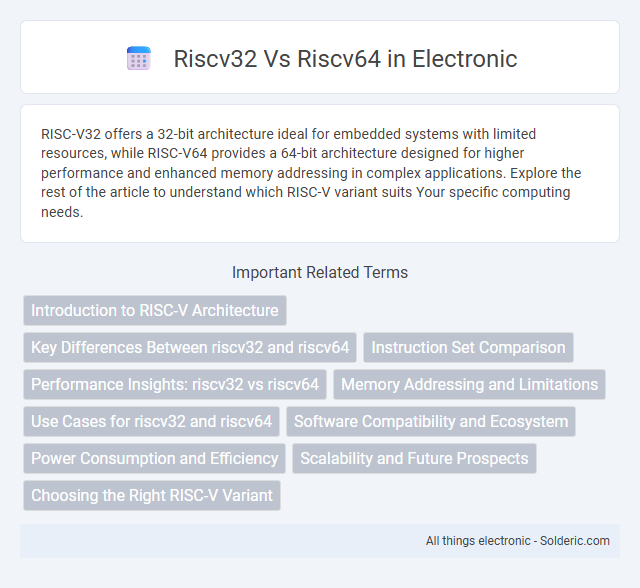RISC-V32 offers a 32-bit architecture ideal for embedded systems with limited resources, while RISC-V64 provides a 64-bit architecture designed for higher performance and enhanced memory addressing in complex applications. Explore the rest of the article to understand which RISC-V variant suits Your specific computing needs.
Comparison Table
| Feature | RISC-V 32 (riscv32) | RISC-V 64 (riscv64) |
|---|---|---|
| Address Width | 32-bit | 64-bit |
| Register Width | 32-bit registers | 64-bit registers |
| Maximum Addressable Memory | 4 GB | 18 Exabytes (2^64) |
| Data Bus Width | 32 bits | 64 bits |
| Common Use Cases | Embedded systems, microcontrollers | High-performance computing, servers, desktops |
| Instruction Set | RV32I and extensions | RV64I and extensions |
| ABI (Application Binary Interface) | ILP32 | LP64 |
| Performance | Lower throughput and memory capacity | Higher performance, supports larger data sizes |
Introduction to RISC-V Architecture
RISC-V architecture supports both riscv32 and riscv64 instruction sets, with riscv32 designed for 32-bit processing and riscv64 for 64-bit processing capabilities. Riscv64 provides enhanced performance, larger addressable memory space, and superior computational precision compared to riscv32, making it suitable for complex applications and operating systems. The modular and open-source nature of RISC-V allows seamless customization and scalability across diverse hardware platforms.
Key Differences Between riscv32 and riscv64
RISC-V32 operates on a 32-bit architecture supporting 32-bit registers and addressing, while RISC-V64 utilizes 64-bit registers and can address significantly larger memory spaces, enhancing performance in data-intensive applications. The instruction sets between riscv32 and riscv64 differ in their default operand widths, with riscv64 offering improved computational capabilities and efficiency for 64-bit data processing. Software compatibility also varies as riscv64 supports both 32-bit and 64-bit applications, whereas riscv32 is limited to 32-bit code execution, impacting system design choices and performance scalability.
Instruction Set Comparison
The RISC-V instruction set architecture (ISA) distinguishes riscv32 and riscv64 primarily by their register width, with riscv32 using 32-bit instructions and addressing, while riscv64 extends these capabilities to 64-bit, allowing for larger address spaces and enhanced computational performance. Both share a common base ISA (RV32I and RV64I respectively) with support for various extensions like integer multiplication/division (M), atomic operations (A), and floating-point (F and D), but riscv64 supports additional compressed instructions and address calculations optimized for 64-bit systems. Understanding these differences in instruction sets can help you optimize software for performance and compatibility depending on the target architecture.
Performance Insights: riscv32 vs riscv64
RISC-V 64-bit (riscv64) architecture delivers enhanced performance compared to riscv32 due to its wider register width, enabling faster data processing and improved memory addressing capabilities that can handle larger datasets efficiently. Applications requiring extensive computational power and memory capacity benefit significantly from riscv64, offering better throughput and scalability over riscv32. Your choice between riscv32 and riscv64 should consider the target workload, as riscv32 may offer lower power consumption and simpler design for constrained environments, while riscv64 excels in performance-critical and high-memory-demand scenarios.
Memory Addressing and Limitations
RISC-V32 supports 32-bit memory addressing, limiting the addressable memory space to 4 GB, which may restrict applications requiring large memory capacity. RISC-V64 features 64-bit memory addressing, allowing access to a vastly larger address space suitable for high-performance computing and memory-intensive tasks. Your choice between RISC-V32 and RISC-V64 should consider the memory requirements of your application to ensure optimal performance and scalability.
Use Cases for riscv32 and riscv64
RISC-V 32-bit (riscv32) architectures are ideal for embedded systems, IoT devices, and microcontrollers where low power consumption and minimal memory footprint are crucial. RISC-V 64-bit (riscv64) architectures excel in high-performance computing, servers, and complex applications requiring large address spaces and enhanced computational capabilities. Both variants leverage the modular RISC-V ISA, but riscv64 targets workloads demanding extensive memory addressing and advanced processing power.
Software Compatibility and Ecosystem
RISC-V32 and RISC-V64 architectures differ significantly in software compatibility and ecosystem support, with RISC-V64 offering broader compatibility due to its ability to run both 64-bit and many 32-bit applications efficiently. The RISC-V64 ecosystem benefits from extensive development tools, operating system support such as Linux distributions optimized for 64-bit, and a growing selection of libraries and frameworks tailored to 64-bit processing. In contrast, RISC-V32 targets embedded and real-time systems with a more limited software stack, emphasizing lightweight, resource-constrained applications and requiring specialized toolchains for optimized performance.
Power Consumption and Efficiency
RISC-V 32-bit processors generally consume less power due to their simpler architecture and reduced instruction width, making them ideal for energy-constrained embedded systems. RISC-V 64-bit processors offer enhanced computational efficiency and performance but typically require higher power consumption because of increased data handling and wider registers. Optimizing for power efficiency depends on balancing workload demands with the inherent trade-offs between the 32-bit and 64-bit RISC-V designs.
Scalability and Future Prospects
RISC-V32 and RISC-V64 architectures differ significantly in scalability and future prospects, with RISC-V64 offering greater addressable memory space and enhanced performance potential crucial for evolving applications. The 64-bit variant supports more complex computing tasks, providing a robust platform ideal for future-proofing embedded systems and high-performance computing. Your choice should consider the growing demand for scalability, where RISC-V64 stands out as the preferred option to accommodate increasing software complexity and data processing needs.
Choosing the Right RISC-V Variant
Choosing between RISC-V32 and RISC-V64 depends largely on application requirements related to memory addressing and performance. RISC-V32 supports 32-bit address space ideal for low-power embedded systems with limited memory needs, while RISC-V64 offers a 64-bit architecture suitable for high-performance computing and applications requiring larger address spaces. Evaluating factors such as system complexity, software ecosystem compatibility, and power constraints is crucial for selecting the appropriate RISC-V variant.
riscv32 vs riscv64 Infographic

 solderic.com
solderic.com